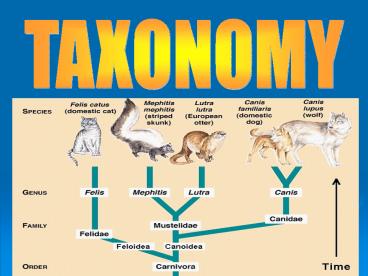Classification System - PowerPoint PPT Presentation
1 / 29
Title:
Classification System
Description:
Discipline of classifying organisms and assigning each organism a universally accepted name Classification System Historically, organisms were classified according to ... – PowerPoint PPT presentation
Number of Views:90
Avg rating:3.0/5.0
Title: Classification System
1
TAXONOMY
Discipline of classifying organisms and assigning each organism a universally accepted name
2
Classification System
- Historically, organisms were classified according
to general characteristics within groups of
organisms, such as whether they had a spinal
chord. After Charles Darwin's theories on
evolution were presented, classifications began
to reflect evolutionary relationships between
organisms.
3
Classification Systems
- Referring to organisms by common names was
confusing for several reasons. - Common names vary among languages
- Different species sometimes share a single common
name - Scientists agreed to use a single Greek or Latin
name for each species because all 18th century
scientists understood Latin and Greek. - Carolus Linnaeus, a Swedish botanist who lived
during the 18th century, developed a two-word
naming system called binomial nomenclature.
4
Linnaeus classification system
- Based on hierarchical system of levels.
- Each level is referred to as a taxon.
- The naming system called Binomial Nomenclature
uses the last two levels to create a two-word
scientific name for each organism. - The genus name is capitolized, whereas the
species name is just underlined. - Often, the species name is a Latinized
description of some important trait of the
organism or an indication of where the organism
lives.
5
Classification systems today are still based on
hierarchical categories. There are now three
domains called Bacteria, Archaea, and Eukarya.
Each kingdom falls into one of the three domains.
6
The two systems
- Six Kingdom System
- Archaebacteria
- Eubacteria
- Protist
- Fungi
- Plants
- Animals
- Five Kingdom System
- Monerans
- Protist
- Fungi
- Animals
- Plants
7
Taxonomy Example for Humans
- Domain
- Kingdom
- Phylum
- Class
- Order
- Family
- Genus
- Species
- Eukarya
- Animal
- Chordate
- Mammal
- Primate
- Hominid
- Homo
- Sapien
8
Domain Bacteria
- Prokaryotic (cells have no nucleus)
- Unicellular
- Have cell walls containing peptidoglycan.
- Extremely diverse group including autotrophs,
heterotrophs, aerobes, anaerobes, and parasites.
9
Domain Archaea
- Prokaryotic (cells have no nucleus)
- Unicellular
- Have cell walls without peptidoglycan.
- Many in this group live in extreme environments
such as volcanic hot springs and black organic
mud devoid of oxygen. - Includes autotrophs, heterotrophs, aerobes, and
anaerobes.
10
Domain Eukarya
- All Eukaryotes (cells have a nucleus)
- Unicellular or multicellular
- Autotrophs or heterotrophs
- Examples include unicellular organisms, algae,
fungi, plants and animals
11
Prokaryotic cell
Eukaryotic cell
12
Kingdom Eubacteria
- Bacteria, which are simple single-celled
organisms that are Prokaryotic (have no nucleus
and few organelles). - Have cell walls with peptidoglycan.
- Unicellular organisms.
- Include autotrophs and heterotrophs.
- Examples include Streptococcus, and E. coli.
13
Streptococcus bacteria
Staphylococcus aureus
E. coli bacteria
14
Kingdom Archaebacteria
- Bacteria, which are simple single-celled
organisms that are Prokaryotic (have no nucleus
and few organelles). - Have cell walls without peptidoglycan.
- Unicellular organisms.
- Include autotrophs and heterotrophs.
- Examples include Methanogens and halophiles
15
Halobacteria
M. jannaschii
16
Kingdom Protista
- Protists are single and multicellular organisms
most of which live in water. - Plant like protists contain chloroplasts and
make their own food. Ex) Algae, Kelp - Animal like protists are single celled and move
by using pseudopodia, flagella, or cilia. Ex)
Amoeba, Paramecium - Fungus like protists include water molds and
mildews.
17
Plant-like Protists Chlorophytes (green algae)
Animal-like protists Amoeba
Fungus-like protist Stylonychia
18
Kingdom Fungi
- Fungi can be unicellular but are mostly
multicellular organisms that decompose dead
matter in our environment. - They are heterotrophs and are responsible for
doing a major cleaning role in our environment. - Fungi are found in soil, dead trees and even on
your bread sometimes.
19
Kingdom Plantae
- Plants are multicellular organisms that are
characterized by their tough cell walls and
photosynthetic abilities. - They are producers and make up the base of the
food chain. - Divided into groups which include mosses,
liverworts, horsetails, club mosses, ferns,
gymnosperms ( cone bearing plants), and
angiosperms ( flowering plants).
20
(No Transcript)
21
Kingdom Animalia
- The Animal Kingdom is very diverse and very
large, numbering over one million identified
species. - Some are vertebrates (backbone), while most (97)
are invertebrates (no backbone). - All animals share the following characteristics
cannot make own food, digest their food, move
from place to place, and have many Eukaryotic
cells.
22
(No Transcript)
23
Identify the Kingdom
24
Identify the Kingdom
25
Identify the Phylum
26
Identify the Phylum
27
Identify the Class
28
Identify the Class
29
Identify the Class































